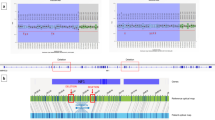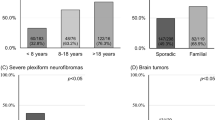Abstract
NEUROFIBROMATOSIS type 1 (NF1) is a common autosomal dominant disorder with a high mutation rate and variable expression, characterized by neurofibromas, café-au-lait spots, Lisch nodules of the iris, and less frequent features including bone deformities and learning disabilities1. The recently cloned NF1 gene encodes a transcript of 13 kilobases from a ubiquitously expressed locus on chromosome 17 (refs. 2–4). Most NF1 patients are expected to have unique mutations, but only a few have so far been characterized, restricting genetic and functional information and the design of DNA diagnostics. We report an unusual NF1 mutation, that of a de novo Alu repetitive element insertion into an intron, which results in deletion of the downstream exon during splicing and consequently shifts the reading frame. This previously undescribed mechanism of mutation indicates that Alu retrotrans-position is an ongoing process in the human germ line.
This is a preview of subscription content, access via your institution
Access options
Subscribe to this journal
Receive 51 print issues and online access
$199.00 per year
only $3.90 per issue
Buy this article
- Purchase on Springer Link
- Instant access to full article PDF
Prices may be subject to local taxes which are calculated during checkout
Similar content being viewed by others
References
Riccardi, V. M. & Eichner, J. E. Neurofibromatosis: Phenotype, Natural History and Pathogenesis (Johns Hopkins, Baltimore, 1986).
Wallace, M. R. et al. Science 249, 181–189 (1990).
Cawthon, R. M. et al. Cell 62, 193–201 (1990).
Viskochil, D. et al. Cell 62, 187–192 (1990).
Daniels, G. R. & Deininger, P. L. Nucleic Acids Res. 13, 8939–8954 (1985).
Marchuk, D. A. et al. Genomics (in the press).
Jadayel, D. et al. Nature 343, 558–559 (1990).
Lehrman, M. A., Goldstein, J. L., Russell, D. W. & Brown, M. S. Cell 48, 827–835 (1987).
Markert, M. L., Hutton, J. J., Wiginton, D. A., States, J. C. & Kaufman, R. E. J. clin. Invest. 81, 1323–1327 (1988).
Berkvens, T. M., Van Ormondt, H., Gerritsen, E. J. A., Khan, P. M. & Van Der Eb, A. J. Genomics 7, 486–490 (1990).
Mitchell, G. A. et al. Proc. natn. Acad. Sci. U.S.A. 88, 815–819 (1991).
Matera, A. G., Hellmann, U. & Schmid, C. W. Molec. cell. Biol. 10, 5424–5432 (1990).
Matera, A. G., Hellmann, U., Hintz, M. F. & Schmid, C. W. Nucleic Acids Res. 18, 6019–6023 (1990).
Batzer, M. A. & Deininger, P. L. Genomics 9, 481–487 (1991).
Batzer, M. A. et al. Nucleic Acids Res. 19, 3619–3623 (1991).
Labuda, D. & Striker, G. Nucleic Acids Res. 17, 2477–2491 (1989).
Jurka, J. & Milosavljevic, A. J. molec. Evol. 32, 105–121 (1991).
Sambrook, J., Fritsch, E. F. & Maniatis, T. in Molecular Cloning, A Laboratory Manual 2nd edn (Cold Spring Harbor Press, New York, 1989).
Ginsburg, D. et al. Proc. natn. Acad. Sci. U.S.A. 86, 3723–3727 (1989).
Author information
Authors and Affiliations
Rights and permissions
About this article
Cite this article
Wallace, M., Andersen, L., Saulino, A. et al. A de novo Alu insertion results in neurofibromatosis type 1. Nature 353, 864–866 (1991). https://doi.org/10.1038/353864a0
Received:
Accepted:
Issue Date:
DOI: https://doi.org/10.1038/353864a0
This article is cited by
-
On the genetic basis of tail-loss evolution in humans and apes
Nature (2024)
-
Novel, heterozygous, de novo pathogenic variant (c.4963delA: p.Thr1656Glnfs*42) of the NF1 gene in a Chinese family with neurofibromatosis type 1
BMC Medical Genomics (2023)
-
The discovery of multiple active mys-related LTR-retroelements within the Neotominae subfamily of cricetid rodents
Genetica (2023)
-
Novel, heterozygous, pathogenic variant (c.4272delA: p.I1426Ffs*2) for the NF1 gene in a large Chinese family with neurofibromatosis type 1
Molecular Biology Reports (2023)
-
More than causing (epi)genomic instability: emerging physiological implications of transposable element modulation
Journal of Biomedical Science (2021)
Comments
By submitting a comment you agree to abide by our Terms and Community Guidelines. If you find something abusive or that does not comply with our terms or guidelines please flag it as inappropriate.



